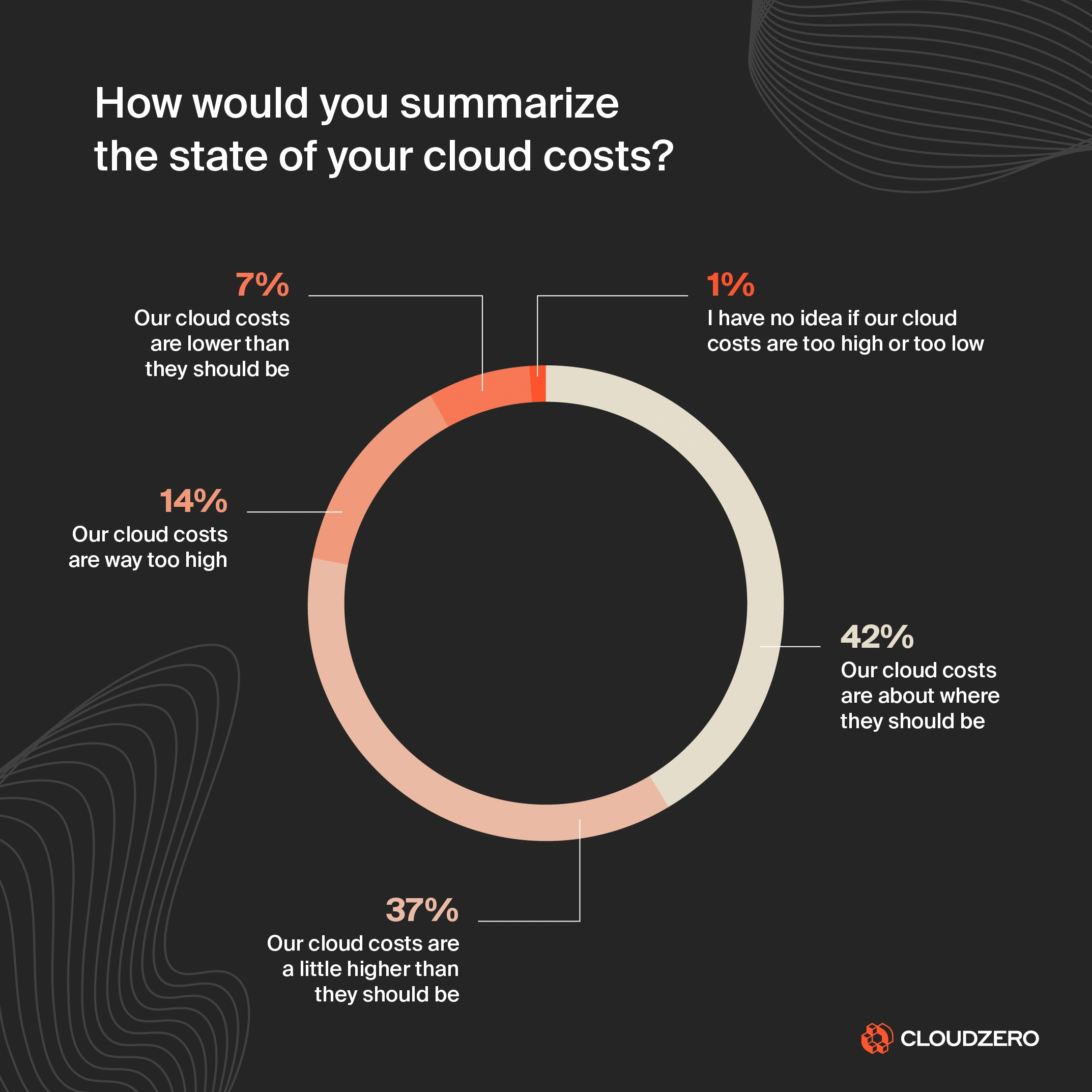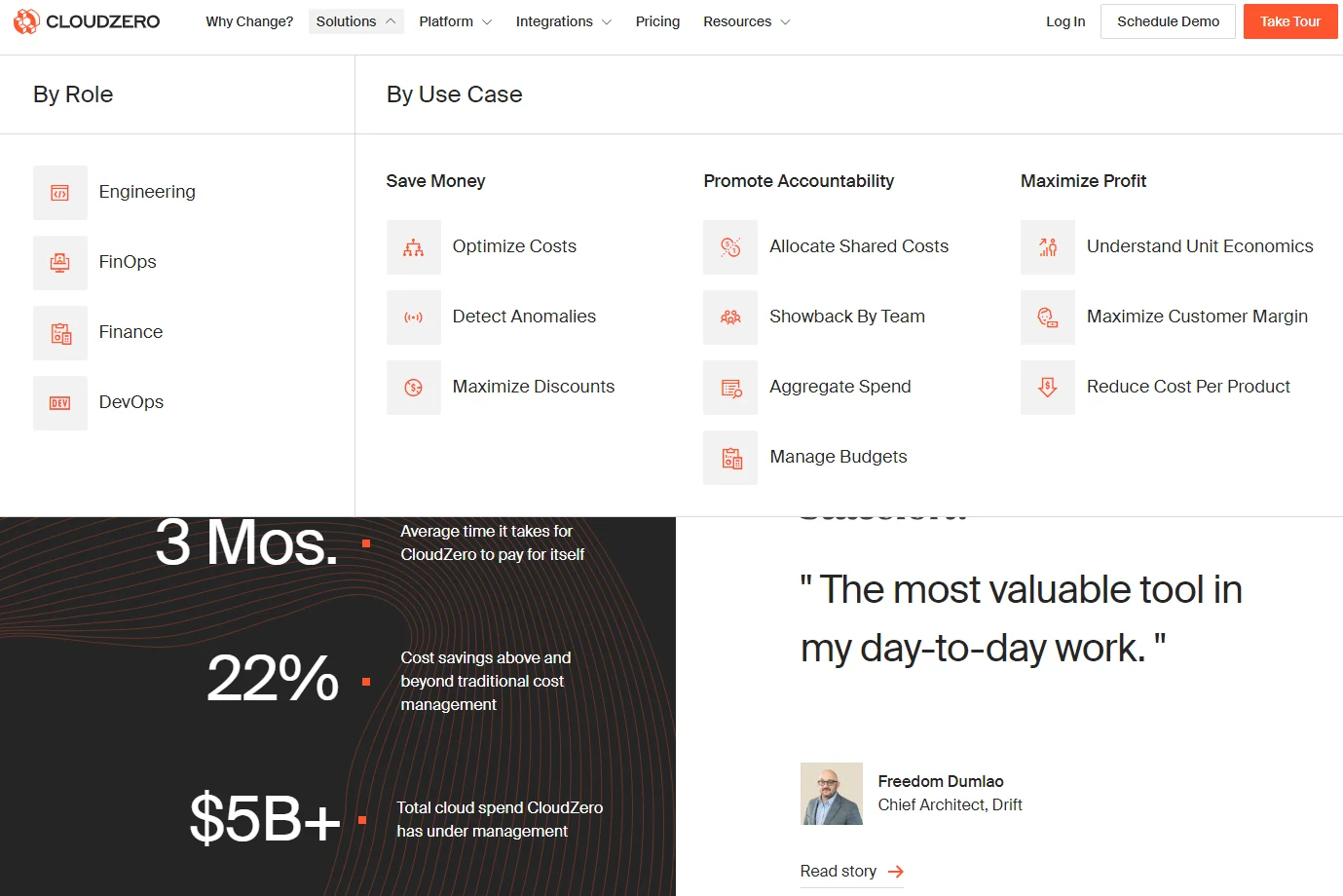SaaS spend waste is a lot like a garden overrun with weeds. Just as weeds consume nutrients and water meant for flowers and vegetables, the waste drains financial resources that could have spurred growth and innovation.
But that doesn’t have to be the case. In this post, we share key SaaS spend management best practices we’ve picked up over the years.
Understanding SaaS Cost Optimization
Consider this. Many organizations find themselves in a cycle of overspending, with 58% of companies estimating that their costs are too high.

CloudZero’s State of Cloud Cost 2024 Report
This waste often stems from avoidable factors such as unnecessary subscriptions, excessive data retention, and AI initiatives that tend to inflate costs.
By patching financial leaks, your SaaS company can steer towards a more sustainable and profitable future.
To achieve that, you’ll want to adopt robust cost optimization strategies, improve visibility into your SaaS spend (and cloud environments), and apply cost governance best practices that ensure every dollar spent contributes to your strategic goals.
This might sound like a lot of work, but here are some rewards you can expect.
Why SaaS Cost Optimization Matters In 2025
Here are some key perks of tracking and optimizing your SaaS costs.
Cost visibility
If you can’t see it, you can’t manage it. Collecting, analyzing, and managing your SaaS expenses can deliver the detailed insights you need to monitor all your subscriptions and costs. From here, you can more easily identify unnecessary costs and tweak your usage to reflect the new intel.
Reduce waste
Once you visualize who, what, and why your SaaS costs are how they are, you can eliminate redundant licenses and underutilized applications, ultimately minimizing waste. You can’t afford not to.
Improve SaaS ROI
Reducing unnecessary expenses means that every dollar spent on SaaS contributes to your business objectives. This can look like being able to allocate spend to the most high-impact tools, maximizing the return on investment on them.
Prevent shadow IT
Keeping unauthorized applications out of the system can minimize security risks that lead to budget overruns. IBM estimates that the cost of resolving a single data breach today can reach over $4.5 million.
Improve budgeting
With accurate data on SaaS usage and spending, your teams can make informed budgeting decisions, aligning your allocations with strategic goals, high-impact tools, and operational priorities.
License optimization
SaaS spend optimization helps you continuously identify unused, overlapping, or underused licenses. This can help your people adjust subscriptions based on actual needs and avoid overpaying for excess capacity.
Streamline renewals
SaaS spend management can help you rethink contract terms, cancel auto-renewals, and remove tools that don’t fit your needs anymore.
Centralize SaaS cost management
A unified platform provides a holistic view of all SaaS applications. This makes it easier to manage subscriptions, oversee vendors, and track costs across departments.
Increase compliance and governance
By maintaining oversight of all software purchases, organizations can ensure compliance with internal policies and external regulations related to software usage.
Agility in decision-making
Real-time data on SaaS spending allows companies to quickly adapt their strategies based on changing business needs or market conditions. And this can foster a more agile operational environment.
That said, preventing cost surprises starts with understanding how you incur the SaaS costs. Here’s how.
Common SaaS Cost Sinks And How To Avoid Them
Consider these seven common cost sinks in SaaS spend management, along with potential solutions and relevant examples for each:
Underutilized licenses
Picture this. A staggering $127 million is wasted yearly on unutilized software licenses, commonly called “shelfware” in an enterprise organization. That’s about 42% of software licenses, according to new data from Zylo.
Redundant applications
Companies often subscribe to multiple tools that serve similar functions. These are also called overlapping apps. Marketing, sales, and customer support tools, often purchased in large numbers, are major culprits here, according to the SaaS spend solutions platform CloudEagle.

Image: SaaS Spend Report – CloudEagle.
Lack of visibility into spending
Our State of Cloud Cost report shows a staggering 89% of respondents said poor cloud cost visibility impacts their ability to do their jobs.
According to CloudEagle, cloud providers such as AWS, Azure, and GCP account for the highest SaaS purchases, accounting for 45% of the collective spending.
Additional Zylo data shows that SaaS license waste rises as employees and company size increase. This may indicate increased visibility issues across teams as they grow bigger and use more SaaS. It gets tougher to pinpoint who, what, and why SaaS costs are changing.

SaaS license waste data by Zylo
Inefficient contract management
Organizations often miss renewal dates or fail to negotiate favorable terms, culminating in higher costs. It’s common for most subscriptions to be auto-renewed these days, but that often leads to paying for tools you no longer need.
Shadow IT
Employees may use unauthorized applications without IT’s knowledge, leading to untracked spending and security risks. CloudEagle calls this the “Citizen SaaS buyer”, where individual or small teams across departments do very use-case-specific SaaS buying. According to the company, about 40% of all SaaS purchases happen this way now.
Overprovisioning resources
Companies frequently overestimate their resource needs when provisioning cloud services, leading to inflated costs. Cloud-based resources and tools are especially prone to this. Many teams often don’t understand their usage patterns and related costs, especially unit costs, such as cost per feature or cost per team.
Inadequate training on tools
Team members may not fully use the tools they subscribe to without proper training. This leads to inefficiencies, missed opportunities for productivity gains, and squandered subscription money.
Now, how do you eliminate these SaaS cost sinks without sacrificing user experience, innovation, or productivity?
6 SaaS Cost Optimization Strategies To Use Right Away
Start by implementing these practical strategies for SaaS spend optimization.
1. Conduct SaaS audits
Audit your team’s actual usage compared to the licenses they purchased. Capture the number of SaaS applications, associated costs, and other pertinent information. Then, establish clear policies governing software procurement, and conduct regular audits to weed out unauthorized tools.
2. Be proactive about license management
Implement a policy to revoke licenses from inactive users. Set up a notification system to remind users of their inactivity. Then, cancel the license after a certain number of days of inactivity, such as 30 days.
3. There’s room to negotiate SaaS contracts
As Nick Riley, Head of Purchasing at Vertice, points out, Q1 is often the best time to negotiate and buy SaaS tools. The reason is, he says, that many suppliers are desperate for new logos and so tend to offer incredibly large discounts during this time.
CloudEagle offers more tricks:
- Negotiate based on the high-growth promise, since you may require more services or seats soon.
- Position yourself as a partner rather than just another customer by providing valuable feedback on the product and suggesting improvements.
- Ask for discounts in exchange for the vendor using your name for publicity campaigns.
- Do a product exchange. Provide your product at a reduced price in exchange for the vendor’s product licenses.
Let your imagination run wild.
4. Right-size subscriptions
Engage with teams to understand their software needs better and gather feedback on which tools are essential versus not so much.
Additionally, consider switching to user-based licensing models that some vendors offer, where you only pay for active users instead of a flat rate for all licenses. Also, platforms like Zylo analyze feature usage and recommend downgrades for users not utilizing advanced capabilities.
5. Reduce redundancies/consolidate tools
Perform a comprehensive review of all SaaS applications to identify overlaps and consolidate tools. Not only does it save money, but it also consolidates workflows, which may improve productivity.
6. Take advantage of 100% cost allocation
This will greatly improve your cost visibility. No matter how complex your needs are, cloud cost optimization solutions such as CloudZero guarantee 100% cost allocation within hours.
Also, CloudZero’s unit cost approach makes sense since most purchases are made through cloud providers. Besides allocating 100% of your cloud SaaS spend, you can also map it to the exact people, products, and processes that incurred it.

In essence, you can see who, what, and why your SaaS spending in the cloud is changing — and do something about it.
SaaS Cost Metrics To Keep An Eye On
Here are five critical SaaS spend management metrics to track ASAP:
1. License Utilization Rate
This metric measures the percentage of active licenses compared to the total number of licenses purchased. High utilization rates indicate that employees are effectively using the software. Low rates suggest potential waste and the need for right-sizing.
2. Total Cost of Ownership (TCO)
Maintain a detailed record of all costs associated with each SaaS tool. These include subscription fees, implementation costs, support, and any additional expenses related to usage. Then make informed decisions about renewals or cancellations.
3. Return on Investment (ROI
Calculate ROI by comparing the benefits gained (such as increased productivity or revenue) against the total costs incurred for the software, justifying its expense.
4. Churn Rate
This indicates the percentage of users who stop using a SaaS application over a specific period. A high churn rate may signal dissatisfaction with the software or better alternatives available, prompting a review of the tool’s value.
5. Spend Growth Rate
Compare current spending against previous periods and analyze the factors contributing to any increases. Take corrective actions if spending exceeds budget expectations.
But What If Tracking, Understanding, And Optimizing The Costs Of Cloud-Based Applications Keeps You Awake At Night?
You’ll need a robust cloud cost optimization platform if you want to do that for platforms like Snowflake, Kubernetes, New Relic, MongoDB, Redshift, and others (including AWS, Azure, and GCP).
Consider this:

Drift (saved over $2.4 million), Uptly (just saved $20 million), and MalwareBytes use CloudZero to do just that — and you can, too (risk-free).  to experience CloudZero for yourself.
to experience CloudZero for yourself.








